Sustainable Development Goals Assignment: Food Poverty In UK
Question
Task: It is your responsibility to ensure that your assignment arrives before the submission deadline stated above. See the University policy on late submission of work.
Task Overview
This assignment is a research and design task for which you must produce a 2-part report (part A and B below). The research and design domain for this assignment is food poverty in the UK.
Part A) Rich Picture of Secondary Research
In this assignment, you will be required to conduct secondary research in order to develop understandings of a particular social issue or context. This can involve, for example, online research, reading academic articles, and reading books. The topic of the secondary research for this assignment is food poverty in the UK. This could include, for example, data on experiences of food poverty and effects on everyday life, organisations that provide services for people in food poverty, food poverty in the media, and adoption and use of ICT in relation to food poverty and organisations/services associated with this.
Using your secondary research, you must analyse your findings to produce a Rich Picture of the design context. A Rich Picture is a diagrammatic approach to explore and understand a phenomenon or design context. It uses graphs, cartoons, words, symbols, etc. It can include in its representation things like people, processes, structures, issues expressed by people, conflict, and climate[1]. You must annotate your diagram by making reference to sources from your secondary research and a short explanation of the relevant findings from these. Your report should include a page of numbered annotations making citations to secondary research, and you should label the parts of your Rich Picture with the numbers of relevant annotations.
Part A of your report should contain the following:
- A Rich Picture (max. 1 page)
- Numbered annotations with citations linking to your Rich Picture (max. 1000 words)
Part B) Design Fiction
Based on the Rich Picture you developed in Part 1 and the secondary research you have done, you must design a digital technology concept to bring about social change in relation to food poverty, and create a design fiction to represent and critically reflect on how it might be interacted with and experienced. This can take any written form of your choice. For example, a customer review, a radio advert, terms and conditions of use, etc. You must then
[1] Rich Picture: https://www.betterevaluation.org/en/evaluation-options/richpictures
discuss your rationale for the design fiction. Part B of your report should contain the following:
- Your design fiction (max. 500 words)
- A discussion of your rationale for the presented design fiction, making reference to your secondary research focused broadly on food poverty in the UK, and Rich Picture (max. 500 words)
- A critical reflection on what your design fiction says about existing HCI literature relevant to social change. This might include topics like food, social justice, marginalised communities, or politics of participation. (max. 500 words excluding references)
Answer
Part A
Rich Diagram
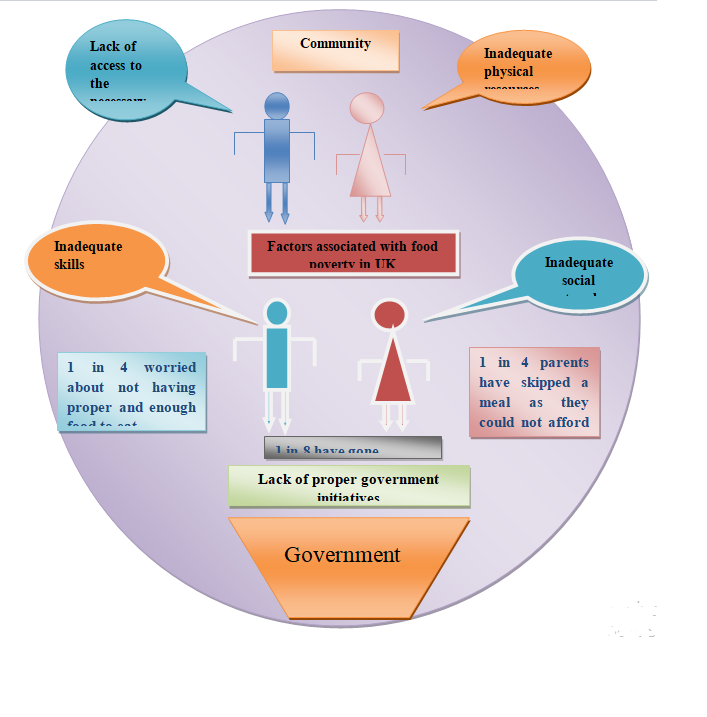
(Source: https://bristolfoodpolicycouncil.org/wp-content/uploads/2013/08/Food-Poverty-Report-July-2013-for-publication.pdf)
What is impact of Food Poverty in the UK in regards to the sustainable development goals assignment?
According to the investigation carried on sustainable development goals assignment, there was a rapid price rise in the real prices of food. This was mainly with fruits, vegetables, and meat. There were several falls in income for the overall low low-income docile groups. There were a lot of consequences faced by low-income people. Low-income people changed their diet in response to the increased rate of food prices. The real incomes had been squeezed and the lower demand for the more expensive calories had been found. This includes fruit and vegetables too. In such an aspect, the poorest have struggled the most for the insufficiency of proper food.
The consequences were that there was a switch in the cheap calories that includes saturated fats, a sugar that is been processed, and also to a reduced number of vegetables and fruit. This had a huge effect on the nation's health. Obesity also had a continuous phase of increasing during this tenure (Bonnar et al. 2018).
It can be said herein sustainable development goals assignment that the price was not only a factor that influenced the overall demand for food. But on the other aspect, consumers mentioned food prices and promotions as one of the determining choices. The table created below shows the income after housing cost which came into effect from 2010-11 hikes. The bar graph shows the graphical representation of the table created below.
Income Decline for the low-income groups
|
Year |
Income after housing cost at 2010-11 prices |
|
2002-03 |
100 |
|
2003-04 |
96.5 |
|
2004-05 |
100 |
|
2005-06 |
95 |
|
2006-07 |
92 |
|
2007-08 |
90 |
|
2008-09 |
82 |
|
2009-10 |
87 |
|
2010-11 |
88 |
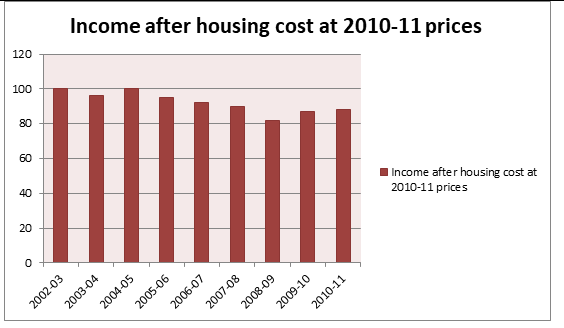
(Source: https://www.researchgate.net/publication/259543656_Income_distribution_and_middle-income_groups_across_the_world)
Comparing food prices in real times
|
Year |
Food prices in real terms |
|
2002-03 |
100 |
|
2003-04 |
100 |
|
2004-05 |
97 |
|
2005-06 |
97 |
|
2006-07 |
98 |
|
2007-08 |
102 |
|
2008-09 |
105 |
|
2009-10 |
110 |
|
2010-11 |
110 |
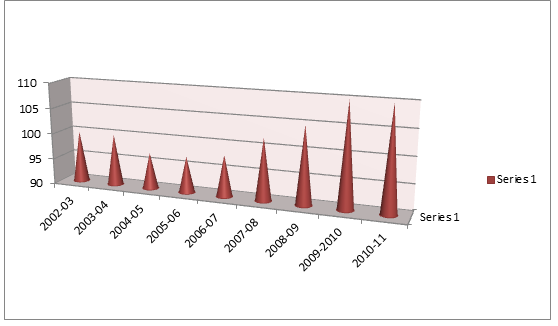
(Source: https://www.which.co.uk/news/2019/11/heres-how-our-food-prices-compare-to-30-years-ago-and-you-might-be-surprised/ )
On the other hand, it is also clear on this sustainable development goals assignment that the median income after the overall housing cost fell with 12% between the years 2002-03 and also with 2010-11 for the overall households comprising of low docile households.
The prices of food had risen by 12% in the real terms over the last five years in the aspect of the cost of food concerning the other goods (Caplan, 2016).
Food price inflation relative to the basic CPI inflation
|
Types of food |
Increase in price from 2007 to 2012 |
|
Processed food |
36% |
|
Fruit |
34% |
|
Meat |
32% |
|
Milk, cheese, eggs |
31% |
|
Bread, flour, cereals |
29% |
|
Butter, margarine, cooking oils |
29% |
|
Food and nonalcoholic drinks |
29% |
|
Sugar, jam confectionary |
29% |
|
Soft drinks |
27% |
|
Coffee, tea, cocoa |
27% |
|
Vegetables, potatoes |
22% |
|
Catering |
19% |
|
Alcoholic drinks |
19% |
|
Fish |
17% |
|
All items CPI |
16% |
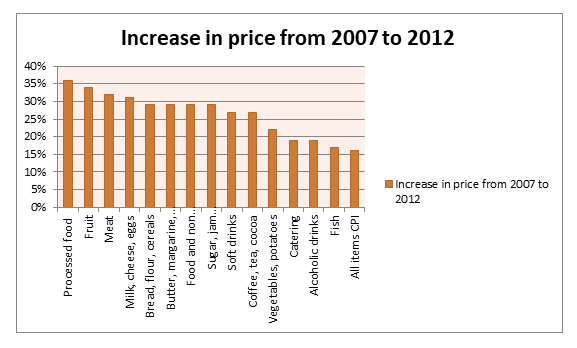
There are several effects in the food prices with the demand of food groups
(Source: https://www.statista.com/statistics/306648/inflation-rate-consumer-price-index-cpi-united-kingdom-uk/)
Percentage change in food purchases in 2007-2010 with the low equivalised through the income docile (UK)
|
Food |
Percentage change in food purchase |
|
Flour |
24% |
|
Alcoholic drinks |
13% |
|
Non- carcass meat |
5% |
|
Processed foods |
-1% |
|
Soft drinks |
-3% |
|
Cheese |
-5% |
|
Average of all foods |
-11% |
|
Vegetables |
-15% |
|
Fruit |
-25% |
|
Carcass meat |
-26% |
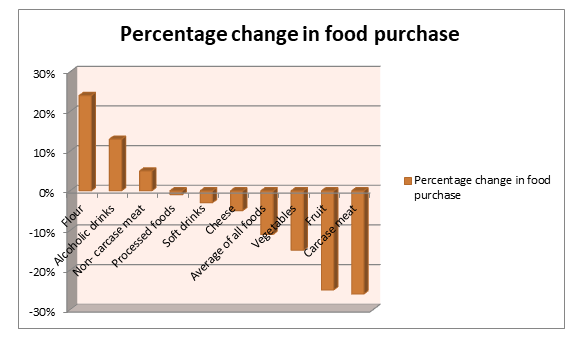
(Source: https://www.gov.uk/government/publications/food-statistics-pocketbook-2017/food-statistics-in-your-pocket-2017-prices-and-expenditure)
As per the analysis provided in the sustainable development goals assignment, there was an observation of a price hike in the fruit which was about to 35% and also was encountered as the second largest fall in the overall demand that raised to -25%. This mainly marks that fruits are highly sensitive and also had a changing of price concerning the income. This was in such a condition because it was usually hard to separate the income and price effect with the falling in income and the rising of the price associated with the elasticity. The people of the UK did not find it as a necessity which would help in substituting other types of food. This can also be considered as luxury goods with income elasticity greater than 1. Therefore, considering the overall evaluation done within the sustainable development goals assignment, it can be said that the falling of income level makes a bigger percentage fall in the overall demand (Caraher & Coveney, 2016).
Food prices in the past three decades
|
Year |
Food prices |
|
1980 |
100 |
|
1982 |
95 |
|
1984 |
92 |
|
1986 |
85 |
|
1988 |
83 |
|
1990 |
82 |
|
1992 |
81 |
|
1994 |
80 |
|
1996 |
75 |
|
1998 |
79 |
|
2000 |
79 |
|
2002 |
80 |
|
2008 |
75 |
|
2006 |
76 |
|
2008 |
70 |
|
2010 |
81 |
|
2012 |
85 |
(Index Jan 1990 = 100)
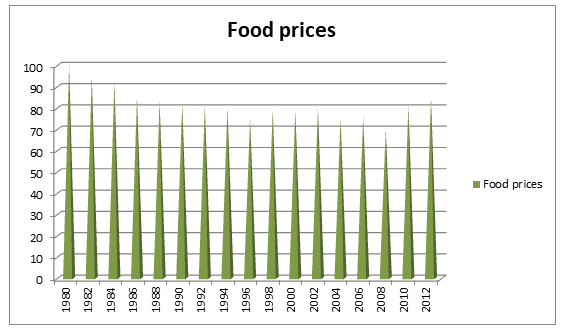
(Source: https://www.bankofengland.co.uk/knowledgebank/how-have-prices-changed-over-time)
The recent increase in the price of food is mainly considered from the overall long term decline in the prices since the year 1980.
In England, it has been seen that 2010 obesity rates increased in all the age bands starting from adults that are aged 25-34 which had the largest rise at 36%. On the other side, the overall rate of obesity mentioned in the sustainable development goals assignment is 26% in 2010.
In January 2019, the Environmental Audit Committee has published their latest report based on Sustainable Development Goals in the UK for the follow-up Hunger, malnutrition and also based on the food insecurity in the UK (Colby, 2017).
The main findings obtained in the sustainable development goals assignment state that:
- The insecurity of food is significant and also growing in the UUK industry that levels in the worst condition starting from Europe and especially to the children.
- The government has mainly failed in the recognition and responding of domestication with an issue of “fall between the cracks”.
- The government obesity strategy is mostly silent based on food insecurities.
- There should be a proper appointment of the hunger minister to ensure proper cross-departmental action. This would enhance the
In the sustainable development goals assignment, it can be said that there is a need to ensure Government based on cross-departmental understanding and also on the understanding of action on hunger and in the implementation of strategies for the monitoring of progress.
About 8.4 million (10.1%) people in Britain were living in the household with adults reported for the basic insecurity. But on such an aspect of poverty illustrated herein sustainable development goals assignment, either UK or NI has no accepted indicator for the measurement of poverty in food (Eskandari et al. 2019).
The cost of different food baskets
|
Cost |
Significant |
|
£ 17.66 |
The lowest price (1-week emergency cost of food parcel) (2018) |
|
£ 57.05 |
The basic consensual standard of the budget in the pensioner's food basket (2016) |
|
£ 56.80 |
Average UK household food expenditure (2017) |
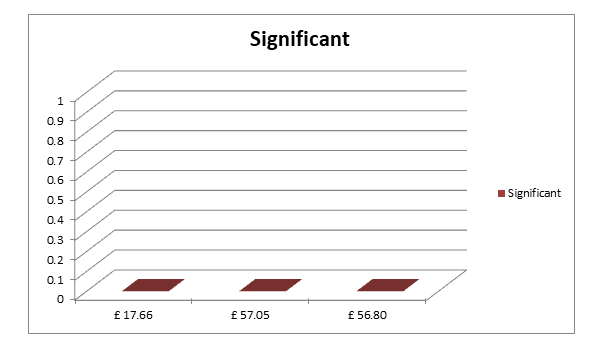
Therefore, it can be said in the sustainable development goals assignment that the charitable sector has approximately £9 million which are to be feed by the most vulnerable citizens at the retail price levels.
(Source: https://www.food.gov.uk/research/national-diet-and-nutrition-survey/cost-of-a-healthy-food-basket-for-households-on-the-island-of-ireland-northern-ireland-research)
Part B
Design fiction: The typology for understanding a design fiction explored in the sustainable development goals assignment has a new approach with the research design. The typology mainly allows design research to explain the fictions according to the five criteria's which are dependent on the scenarios which are considered as the basic construal principle of the design fiction, the manifestation of critique, design aims, forms and materialization, the aesthetic design fiction. The overall typology is mainly associated with the fiction that may integrate with reality in certain different aspects with different experiments. The provision of clean energy in regions at certain places where the modern energy services that are not yet available also offers a perfect opportunity in sustainable development. The direct provision of electricity with the medium of the renewable energy system has a definite potentiality to address the three core UN Sustainable Development Goals (SDGs): includes in the eradicating of poverty, clean providing and proper affordability of modern energy with an infrastructure which will strengthen the ability for managing clean water, quality education, good health, reductions in specific inequalities (Knight et al. 2018). The deployment of clean energy is not enough to achieve broader benefits with the rapid scale designing process. Therefore the distributed energy system at times faces severe challenges concerning socio-technical design challenges. If the designing process is done properly, then the innovation will help in balancing the ecosystem. This will also create a long term socio-economic benefits and will also create in lifting large numbers of energy out of the economic poverty and will create a broad resilience on the keeping up the community from economic poverty. There will be a three-part framework in the design approach of the socio-technical design challenge by providing clean energy to reduce the poverty level and also help in multiple progressions on other DSGs. The three-element framework discussed in the context of sustainable development goals assignment mostly signifies the Social value of energy, Social energy systems, and enterprises, energy innovation in the ecosystem. The social value of energy fundamentally explores with the people that do not care about access to green electrons or the carbon-neutral fuels (McClelland et al. 2018). This further helps in making society reduce poverty, proper access to health, clean water, and proper business opportunities to meet the UN SDGs, which are associated with social value. Therefore the energy system needs to be designed in such a way that it permits the local people to afford the creation. The next is the socio energy system enterprises which are concerned with the deliverable of socio-technological systems that deliver proper energy services with designing, installation, operation, maintenance, and overall expanded energy systems over time. Lastly, it is noted herein sustainable development goals assignment that the third framework which is an energy innovation ecosystem that will help in off-gridding context and attending careful array with elements that are associated with energy innovation and ecosystem. The socio-technological system can be applied in various aspects and a range of geographies working on different cultures as well. This is the fictional technological design that has been created by me to eradicate poverty in the UK. This can help in further eradication of food poverty in UK.
Discussion
The energy and poverty are interrelated with each other. There are about 1 billion people who still do not have access to modern energy services. The other people approximately 2 to 3 billion lack in the reliability, affordability, and clean energy systems with the special contribution of poverty by various means of pathways. A specific amount of energy provided in top contributes to poverty through numerous numbers of pathways. The energy sectors historically offend with corruption and impacts on human rights. There are several multifaceted tracking and evaluating systems with the poverty meet up of SDGs. There is a need for national and international energy systems that are planned with the process of recognition which is measures in kilowatts and other energy measurement services. The quality relation concerning the meeting of the pressing needs irrespective of the user's end. The secondary research thus provided in part A constitutes several statistics related to the cause of low income which made several changes in the identification of the local cultural and economic conditions. These statistics provided in the sustainable development goals assignment have made us understand the overall condition which is prevailing in the UK for three decades. These have also led to several decreases in the overall condition of the UK and its neighboring countries. There are several steps taken by the government to create a long term impact on the suppliers which supports and has created a partnership with the local institution for the nonfunctional units. According to the recent statistics of 2017-18, the Resolution Foundation reckons with the official poverty rate that increased from 22.1% to 23.2%. The child poverty rates roses in the year 2017-2018 from 30.3% to 33.4% (O’Connell, Brannen & Knight, 2018). This cuts to benefits of the level that remains unchanged in the terms of money as well as with the rate of inflation to real values. The main causes of food poverty in the UK mentioned in the sustainable development goals assignment are that approximately 8.4 million people are struggling to eat. The food poverty, household insecurity in food is mainly triggered by finance or personal circumstances. This has made a long term experience which was not being able to have access to a healthy diet. The rich picture which is diagrammatic in the previous part mainly shows poverty in the UK. The parents sacrificed their children to afford food (Psarikidou et al. 2019). This is because the income is decreasing which led to the overall decrease in the consumption rate. Therefore the technology fiction has been made in such a way that there is a proper sustainable energy transfer so that poverty can be decreased properly. Several ways are being made by the private as well as government agencies to uplift the nation with proper steps. The study developed in the sustainable development goals assignment examines that the challenges are faced by the population as well as the neighboring states to overcome the problems of poverty which mainly came from poverty. Several upcoming changes will come up with new designing of technology to overcome the state of poverty in the UK in a proper way (O’Connell & Brannen, 2019).
Critical Reflection on the task explored in the sustainable development goals assignment
The technology fiction of the direct provision of electricity with the medium of the renewable energy system has a definite potentiality to address the three core UN Sustainable Development Goals (SDGs). The technology to utilize the forces of nature includes the supply of human needs that are old with a first sailing ship. There is attention swag which came from the renewable sources with the industrial revolution that are associated with fossil fuels. These are important with portable and high density with the transport resources. The fiction demands electricity and supply depending largely on fossil fuels with the hydropower and also with nuclear energy. It concerns carbon dioxide emissions contributing to possible global warming. The attention again turned with the huge sources of surging in nature that engulfs with sun, wind, and seas in a particular sphere (Colby, 2017). Wind turbines have developed greatly with the recent decades by several solar photovoltaic technologies with more efficiency that are concerned with the improvement of harnessing the tides as well as waves. In such an aspect solar thermal technologies, in particular, can be used a proper league per kilowatt-hour with the cost of fossil fuel technologies. They are especially associated with the electric generation part of the design. This will help run the technology through the production of sustainable energy. There is another thing depicted in the readings of sustainable development goals assignment that is to be taken into consideration which I felt while making the planning of the designing process. They are profile costs, balancing costs, grid costs and also the connection costs to the grid. The connection cost obtained in the context of sustainable development goals assignment mainly associates with the LCOE and with the utilization costs which can be a backup for the researcher as well. There is a further aspect of consideration of grid supply with a true capacity that accounts for discounts for the process of intermittency. In the UK there is a common factor of 0.43 for wind and 0.17 for the solar PV which has hence declared with DNC for the overall national reporting system (Colby, 2017). The mode of nominal capability in generating electric supply will help the people of the UK. The fresh energy will help in decreasing the poverty level from different sections in the society. The design fiction previously was used in several forms in generating electricity through onshore and offshore wind, with the help of the wind turbine. There is system integration on renewable power that has the same electricity generation mechanics (Psarikidou et al. 2019). Several social justices came into force while the initiation and the designing of the fiction. These were being considered while setting up prices as the people are already at the poverty level. So the design fiction is made affordable socially with no environmental harm. Therefore, observing the overall evaluation done within the sustainable development goals assignment it can be said that the government needs to take serious steps to eradicate poverty related to food and other sorts of crisis that are being faced by the people of UK, so that people can stay healthy with adequate amount of food. This will also help in uplifting the overall economics of UK as well.
Reference List
Bonnar, E., Parker, N., Kane, H., & Bowen, C. (2018, September). The psychological impact of food poverty. In the British Psychological Society Community Psychology Festival: I am because we are.
Caplan, P. (2016). Big society or broken society?: Food banks in the UK. Sustainable development goals assignment Anthropology Today, 32(1), 5-9.
Caraher, M., & Coveney, J. (Eds.). (2016). Food poverty and insecurity: international food inequalities. Cham: Springer.
Colby, S. (2017). Why Shopping Frequency is a Key Determinant of Diet-Based Diseases.
Eskandari, F., Lake, A. A., Weeks, G., & Butler, M. (2019). Twitter conversations about food poverty: an analysis supplemented with Google Trends analysis. The Lancet, 394, S38.
Knight, A., Brannen, J., O’Connell, R., & Hamilton, L. (2018). How do children and their families experience food poverty according to UK newspaper media 2006?15?. Journal of Poverty and Social Justice, 26(2), 207-223.
McClelland, N., Furey, S., McKenzie, P., & Hollywood, L. (2018, March). Rural poverty: The impact of rurality on consumers’ access to food services, using a food poverty risk index. In Multi-disciplinary research conference on food and poverty in the UK: Taking stock, moving forward (pp. 39-39).
O’Connell, R., & Brannen, J. (2019). Food poverty and the families the state has turned its back on the case of the UK. Absolute poverty in Europe: Interdisciplinary perspectives on a hidden phenomenon, 159.
O’Connell, R., Brannen, J., & Knight, A. (2018). Child food poverty requires radical long term solutions. Sustainable development goals assignment BMJ, 362, k3608.
Psarikidou, K., Kaloudis, H., Fielden, A., & Reynolds, C. (2019). Local food hubs in deprived areas: de-stigmatizing food poverty?. Local Environment, 24(6), 525-538.












